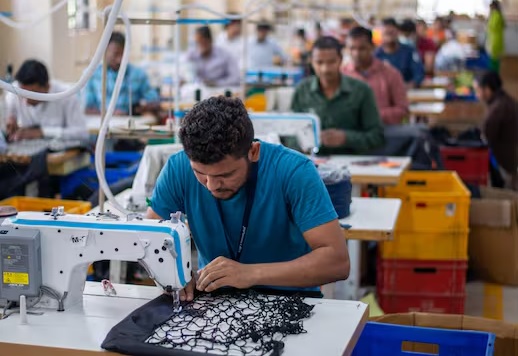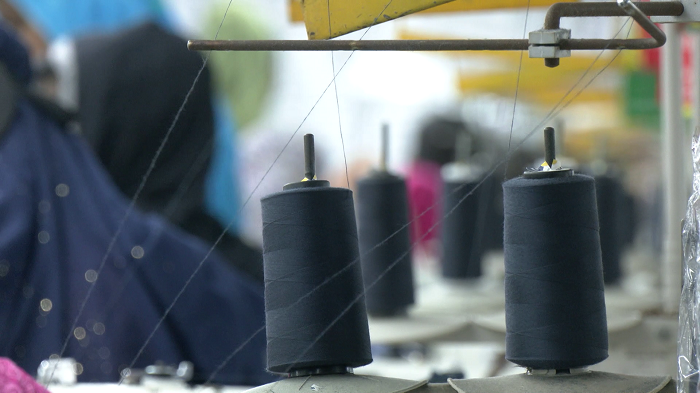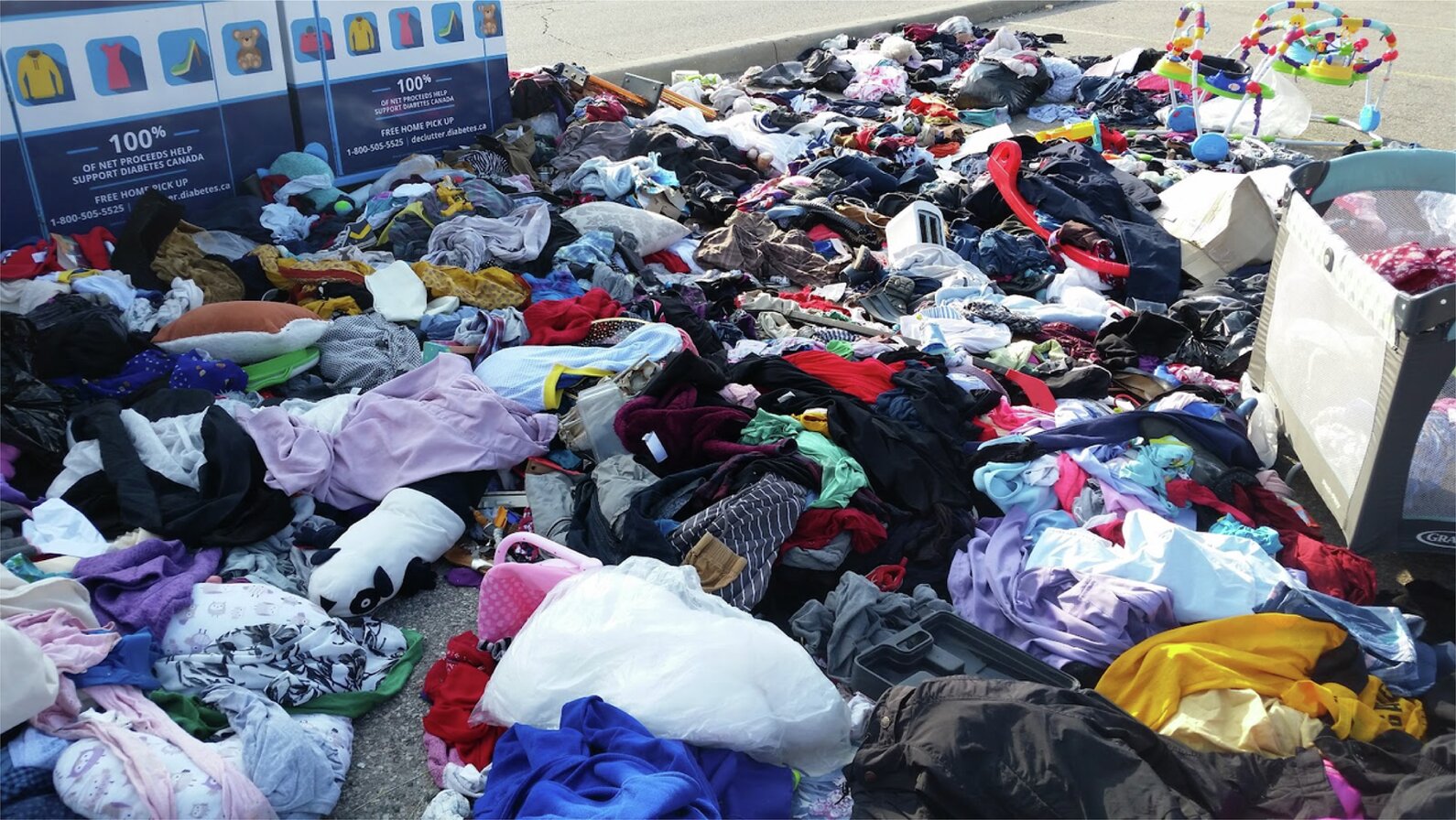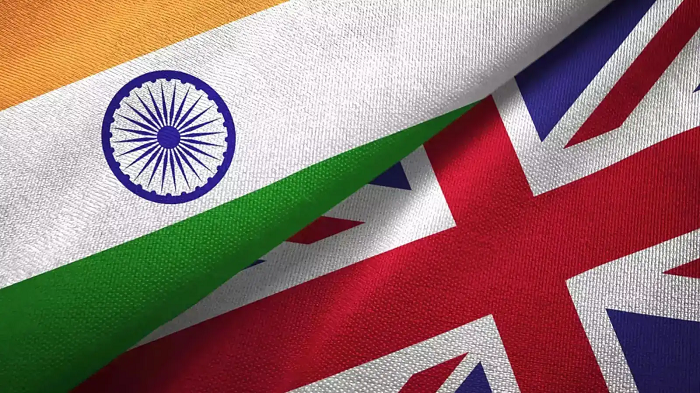The Ethiopian Textile and Garment Manufacturers Association (ETGMA)has called for stricter enforcement of laws against illegal clothing imports and increased support for local manufacturers to help them remain competitive in an increasingly challenging market.
Since the last few months, Ethiopia’s textile manufacturers have beenstruggling to compete with the influx of second-hand garments, known as ‘bonda’ clothingthat has been flooding the market at low prices.
The surge of bonda clothing, colloquially known as ‘Taiwanese’is making it difficult for Ethiopian textile manufacturers to sell their products in the market, says Ageazi G/Selassie, General Secretary, ETGMA. As these second-hand garments are often dry-washed, tagged, and distributed across various boutiques in urban areas, local businesses are unable to compete on price and quality. As a result, many manufacturers are being driven out of the market.
Over the past decade, Ethiopia’s textile and apparel sector has generated approximately $1 billion in export revenue, while imports have totaled around $5.4 billion, resulting in a trade deficit of $4.4 billion. This gap underscores the difficulties faced by the domestic industry, now further compounded by the proliferation of illegal clothing products.
Despite the importing illegal clothing being prohibited under Ethiopian law, the market for these garments is rapidly growing. These products enter the market through various channels and are often sold at prices that are highly attractive to consumers.
The impact of second-hand clothing influx on small-scale manufacturers and vulnerable businesses is particularly severe as they are being forced to quit the market. Local producers in rural areas are being further challenged by a different type of second-hand clothing, known as ‘relief,’clothing.
Asper a study conducted by the association last year, ‘bonda’ clothing accounted for 53 per cent of the Ethiopia’s textile market.This poses a significant threat to local textile industries in Ethiopia and beyond, as consumers increasingly opt for these cheaper alternatives, further pressuring domestic manufacturers.

The ongoing political unrest in Bangladesh has brought the country's apparel industry to its knees. With factories shuttered, transportation halted, and communication networks disrupted, production has ground to a halt, leading to massive order cancellations and financial losses.
“It’s a nightmare scenario,” said President of the Bangladesh Garment Manufacturers and Exporters Association (BGMEA). “We’ve never seen anything like this before. The industry is bleeding.”
Billions of dollars in losses
Industry estimates suggest that the crisis has already cost the apparel sector over $800 million in just a few days and it cost more than $4 bn worth of orders. With each passing day, the losses mount as buyers seek alternative sources for their products.“The financial impact is catastrophic,” says a leading apparel exporter. “We’re facing massive order cancellations and delays. It’s going to take months to recover.”
Global brands fleeing Bangladesh
The crisis is likely to erod confidence in Bangladesh as a reliable manufacturing hub. Global brands are increasingly concerned about production delays, quality issues, and the overall risk of operating in an unstable environment.“We’re closely monitoring the situation and exploring alternative sourcing options,” said a spokesperson for a major global apparel retailer. “The safety and security of our workers is our top priority.”
India poised to benefit
As Bangladesh struggles, India is emerging as a potential beneficiary. With its vast textile industry and existing infrastructure, India is well-positioned to absorb some of the overflow of orders.“This is a golden opportunity for India to showcase its capabilities,”avers an Indian textile industry expert. “We need to be proactive and aggressive in attracting new business.”
Government under pressure
The Bangladeshi government is facing mounting criticism for its handling of the crisis. The opposition is demanding immediate steps to restore order and protect the country’s vital apparel industry.
The crisis is having a devastating impact on the millions of workers employed in Bangladesh’s apparel industry. With factories closed, many are facing unemployment and financial hardship.

The ongoing political and economic instability in Bangladesh is casting a long shadow over the Indian textile and apparel industry. With factories shutting down repeatedly in Bangladesh, the ripple effects are being felt across the value chain.
A hit to Indian raw material exports
India is a major supplier of raw materials like cotton, yarn, and fabric to Bangladesh's thriving apparel sector. The frequent closures of factories due to political unrest have led to a sharp decline in demand for these materials. Indian textile exports to Bangladesh have been volatile and will face major decline during this period of heightened political tension.: "The uncertainty in Bangladesh is hurting our raw material exports badly. We have already seeing a drop-in orders and prices," says a leading exporter.
India exports $2.4 billion worth of its cotton to Bangladesh, according to ministry of commerce data, the share of Bangladesh in India’s overall cotton exports doubled from 16.8% in FY13 to 34.9% in FY24. Raw cotton exports accounted for a fourth of India’s total exports to the country in FY24. Any political instability in Bangladesh could significantly impact India's cotton sector, despite overall trade remaining unaffected.
Global brands to seek alternatives
The disruptions in Bangladesh's apparel production have also caught the attention of global brands. Faced with delayed shipments and quality concerns, these brands are increasingly looking for alternative sourcing destinations. India, with its large textile and apparel industry, is a natural contender.While India is already a significant player in global apparel sourcing, the current situation in Bangladesh presents a unique opportunity to increase its market share."We are closely monitoring the situation in Bangladesh. If the instability persists, we will definitely explore options to diversify our sourcing base," says a sourcing manager for a leading global apparel brand.
A boon for Indian apparel industry
The challenges faced by the Bangladeshi apparel sector could be a boon for Indian apparel brands and retailers. With duty-free access to the Indian market, many Bangladeshi exporters have been supplying garments to Indian players. However, the recent disruptions may compel these brands and retailers to shift their focus to domestic sourcing. India's largest retailer, Reliance Retail, has already announced plans to significantly increase its sourcing from domestic manufacturers. This move is expected to benefit thousands of Indian textile and apparel businesses."We believe in supporting the Indian textile industry. The current situation in Bangladesh provides us with an opportunity to strengthen our domestic supply chain," says a spokesperson for Reliance Retail.
Challenges and opportunities
While the current situation in Bangladesh presents several opportunities for the Indian textile and apparel industry, it also comes with challenges. India needs to address issues such as infrastructure, labor costs, and skill development to effectively capitalize on this situation.Moreover, the industry must focus on product innovation and quality to compete with global benchmarks. By adopting sustainable practices and leveraging technology, India can position itself as a preferred sourcing destination for global brands.
The ongoing turmoil in Bangladesh is creating a complex and dynamic landscape for the Indian textile and apparel industry. While challenges persist, the potential for growth and development is significant.

A wave of cautious optimism has spread across American consumers, reveals Euromonitor International’ latest ‘Voice of the Consumer: Lifestyles Survey’ study. The report, which surveys consumer attitudes and behaviors across 40 countries, reveals a significant shift in sentiment compared to previous pandemic years. “Consumers are feeling more optimistic about the future and increasingly less worried about global affairs,” says Euromonitor in the report’s introduction. “This presents an opportunity for brands to connect with consumers on an emotional level and create positive experiences.”
Shifting consumer outlook
This year's survey marks the highest level of optimism among US consumers since the pandemic began. While cost-of-living pressures remain a concern 72 per cent respondents reported feeling the pinch, consumers are increasingly willing to spend on experiences and brands that resonate with their values. The study also revealed bargain hunting is on the decline (reported by Euromonitor as a key finding in 2022), with a growing preference for brands that align with personal values, even if it means spending a bit more. This is reflected in the success of Coop Italia's lower-cost premium brand Fiorfiore, which targets budget-conscious consumers seeking high-quality products.
Euromonitor attributes the shift in consumer sentiment to several factors. Pandemic fatigue is one of them. After years of navigating lockdowns and uncertainty, consumers are yearning for a sense of normalcy and are more receptive to positive experiences. This aligns with Lego's recent marketing campaign, which capitalizes on the feel-good association of their products for both children and adults.
While inflation remains a concern, consumers are becoming more adept at managing their budgets. The survey suggests a growing openness to the ‘circular economy’, with practices like buying pre-owned goods gaining traction. A recent example is the rise of self-repair options for Apple products in Poland, catering to consumers who want to extend the life of their electronics.
The findings from Euromonitor's survey offer valuable insights for businesses catering to the US market. As consumer priorities shift and optimism cautiously rises, companies that can adapt their strategies to this evolving landscape will be best placed to thrive.
Holding a 7.4 per cent market share, Bangladesh has maintained its position as the world’s second-largest garment exporter, as per a report by the World Trade Organisation (WTO).
Titled, ‘World Trade Statistics 2023,’ the report, released on July 31, estimates, Bangladesh exported garmentsworth $38 billion in 2023.
The leading global garment exporter, China shipped $165 billion worth of apparel, which equates to a 31.6 per cent global market share. Vietnam ranks third with $31 billion in garment exports, capturing a 6 per cent market share. Turkey follows in fourth place with $19 billion in exports and a 3.6 per cent market share. Holding the fifth position, India exported $15 billion in garments, representing a 3 per cent market share.
Indonesia, with a 1.6 percent global market share, exported $8 billion worth of garments in 2023.
The global supply chain faced significant challenges last year due to several factors, including the lingering effects of COVID-19, the Russia-Ukraine war, inflationary pressures on Western consumers, labor unrest demanding wage increases for garment workers, the Red Sea crisis, and rising freight charges.
To celebrate the 10th National Handloom Day, the Textile Ministry is hosting a two-week exhibition called ‘Viraasat from Aug ’06, 2024 at Handloom Haat in Janpath, New Delhi. The event is being organised by the National Handloom Development Corporation (NHDC), a branch of the Ministry.
The exhibition showcases a wide range of handloom products sourced from various unique regions across India, available for both display and purchase. The expo houses 75 stalls featuring handloom weavers and artisans directly selling their products.The products being offered include Banarasi, Jamdani, Baluchari, Madhubani, Kosa, Ikkat, Patola, Tussar Silk, Maheshwari, MoirangPhee, Phulkari, Laheriya, Khandua, and Tangaliya. These exclusive weaves, designs, and traditional motifs continue to attract customers worldwide.
Additional attractions at the exhibition include a curated theme display of exquisite Indian handlooms, workshops on topics like natural dyes, Kasturi cotton, design, and exports, live loom demonstrations, traditional folk dances, and regional cuisine.
The Indian government has launched various initiatives to promote the handloom sector, emphasising the production of high-quality, eco-friendly products. The ministry is encouraging exhibitors at the ‘Virasat’ exhibition to showcase their unique items, aiming to enhance the market for handloom products and boost the income of the handloom community.
Equipped with Longi’s high efficiency HI-MO 5 solar modules, the solar power plant installed by Virdis Engineering in Coimbatore, Tamil Naduprovides significant cost savings for the manufacturer by generating substantial clean energy.
The plant was installed in two phases: the first 1 MW phase was commissioned in May 2023, followed by a 750 kW phase in February 2024. The plant has a remarkable daily generation capacity of 6 units, resulting in an annual electricity bill saving of Rs 1.9 crore.
This integration of solar technology marks a significant technological advancement in the textile industry, reflecting a strong commitment to environmental sustainability. Driven by the mission to make the best of solar energy to build a green world, Longi aims to lead energy-intensive and high-pollution industries, such as textile manufacturing, toward a more sustainable and eco-friendly future. Metakeys: Virdis Engineering, Longi
The global wool yarn market is set to expand at a CAGR of 3.4 per cent from 2024-34 to reach a value of $8.05 billion by 2034.
As per a report by FactMR, East Asia is forecasted to dominate the market, holding a 38.4 per cent share by 2034, with Japan accounting for 28.8 per cent of this share. The South Korea market is expected to grow at a CAGR of 5.6 per cent during this forecast period. China is also projected to be a major player in the East Asian wool yarn market, commanding 57.3 per cent of the regional share by 2034.
Wool's excellent thermal insulation properties drive increased sales of woolen clothing during winter. Additionally, wool's natural and antimicrobial qualities make it a preferred choice for individuals in fast-paced environments where the skin may be prone to microbial infections. The durability, resilience, and resistance to compression of wool yarn make it a popular choice among consumers seeking sturdy and long-lasting garments.
The expansion of the wool yarn market is also fueled by rising demand for high-quality wool, growth in the women's wear segment, and the emergence of consumer markets in developing countries. In particular, the upholstery segment is expected to grow steadily at a CAGR of 3.8 per cent from 2024-34, reflecting the increasing demand for wool yarn in various textile applications. This growth underscores the continued importance of wool yarn in the global textile industry, driven by its versatility and durability.
In the moderately fragmented wool yarn industry, major players hold a significant portion of global revenue. Emerging players occupy the remaining market share. With growing demand for worsted wool yarn, key market players are investing heavily in this segment through partnerships and acquisitions, especially in Europe and East Asia. For instance, in October 2018, Indorama Ventures (IVL) acquired the worsted wool yarn business of Schoeller Group through its subsidiary, Glanzstoff Management GmbH. Metakeys: FactMR
Turkish denim mill Calik Denim plans to expand its Royal Denim fabric collection by introducing double-sided fabrics and exploring unconventional denim categories like leggings.
Designed for high-end and formal wear, the Royal Denim collection features a blend of organic cotton with luxurious materials like cashmere, silk, hemp, and linen, resulting in fabrics with distinct textures and character.
As per Mehmet SerdarOzcan, Sales Director, Calik Denim, offering excellent color fastness and minimal shrinkage, the collection helps retain the durability and appearance of these premium pieces.
Last month, Calik showcased these fabrics at Premiere Vision in Paris, presenting a range of fashion-forward garments. Prominent brands like Prada, Marc Jacobs, Guess, and Karl Lagerfeld have already expressed interest in the Royal Denim collection, adds Ozcan
Calik Denim has already developed indigo products for Lululemon that offer the fit and functionality of leggings but the appearance of denim. The company is committed to quality through its Farm to Store concept, which leverages Turkish cotton grown by its sister company, Calik Cotton. This allows Calik to maintain complete control over its supply chain, ensuring higher quality standards for its clients.
Calik Cotton began cultivating cotton in 2016 and started ginning it by 2018. The cotton is used in fabrics sourced by brands like PVH and Bestseller-owned Jack & Jones, which utiliseCalik’s organic cotton fabrics. As one of Turkey's largest cotton producers, Calik Cotton produces more cotton than the mill currently consumes and the program is set to become available to more clients.
The Cotton Corporation of India (CCI) has procured 33 lakh bales of cotton at the Minimum Support Price (MSP) from farmers during the ongoing cotton season, which is set to conclude next month.
Lalit Kumar Gupta, Chairman and Managing Director, CCI notes, the corporation conducts two e-auctions daily: one specifically for textile mills and another open to all buyers.
Despite these efforts, the offtake by mills has been sluggish, largely due to an accumulation of yarn stocks and a slowdown in demand. For almost 25 days, CCI sold only 25,000-30,000 bales daily. However, sales increased recently with the corporation selling 20,000 bales. Currently, CCI holds a stockpile of nearly 20 lakh bales.
Looking ahead, CCI needs to prepare for the next cotton season that begins October asMSP operations are expected to expand during this period, emphasises Gupta.
Toincentivise textile mills to purchase more cotton, CCI has introduced a new measure allowing mills to take delivery within 60 days from Aug 01, 2024. Additionally, the corporation has appealed to mills to secure their stock requirements for the current cotton season, aiming to boost sales and manage inventory levels more effectively.
- 1
- 2
- 3
- 4
- 5
- 6
- 7
- 8
- 9
- 10
Blossom Premiere Vision returns in June to support luxury fashion's shifting nee…
As the global luxury goods market grapples with a prolonged slowdown, an industry once resilient to crises is now undergoing... Read more
Monforts technologies power sustainability showcase at Kingpins Amsterdam
Denim mills using Monforts systems dominate eco-focused fabric displays At the recent Kingpins Amsterdam exhibition held on April 16-17 at the... Read more
Bangladesh RMG exports navigate new skies amid cost concerns post India's trans-…
Bangladesh's RMG export is adapting to India's revocation of trans-shipment services, marked by maiden freighter flight carrying 60 metric tons... Read more
A stitch in time, fashion's 1% solution to a carbon crisis
The fashion industry, built on trends and textiles, is facing a stark reality: its environmental footprint is unsustainable. Hidden deep... Read more
Threadbare Foundations: Bangladesh’s RMG boom hangs by Indian yarns
Bangladesh’s ready-made garment (RMG) industry is a global juggernaut. Second only to China in apparel exports, the sector is the... Read more
Global fashion brands brace for tariffs, Zara, Shein, H&M, Fashion Nova navi…
Inditex, the parent company of fast-fashion giant Zara, remains "optimistic" about its growth prospects in the United States, even amidst... Read more
Where do donated clothes go? Report debunks landfill myth, highlights global reu…
Forget the image of mountains of discarded clothing polluting landfills. A new white paper by Bank & Vogue Ltd/Ltée reveals... Read more
India-UK FTA: New opportunities beckon Indian fashion retailers and brands
The just concluded Free Trade Agreement (FTA) between India and the UK, a culmination of over three years of negotiations,... Read more
ESG backlash and the future of sustainability in textiles, apparel, and fashion
Julia Vol’s LinkedIn post, echoing the Financial Times headline ‘ESG fund outflow hit record as sustainable investing backlash grows’, strikes... Read more
Hermès' Singular Vision Pays Off: Overtakes LVMH in market cap through decades o…
In a compelling narrative of focused growth versus diversified expansion, luxury powerhouse Hermès has shown the power of brand discipline,... Read more












